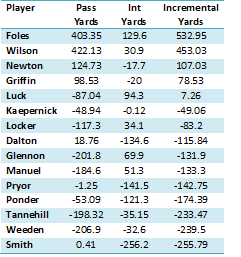[adsenseyu1]
With all the recent talk about the young QB’s in the NFL I wanted to take a look using my incremental yards matrix as to how they are performing in 2013. For those unfamiliar with these numbers that I use the way it works is that using data supplied by Pro Football Focus relating to length of passes we can determine how many yards an average QB would pass for on a similar set of throws. By comparing the two we can determine just how many yards the QB actually contributed to the team. The average YPA is as follows:
Behind the Line- 5.8 yards
0 to 9 yards- 6.2 yards
10 to 19 yards- 9.5 yards
20+ yards- 11.7 yards
In addition we can calculate the expected interceptions and use that to calculate yards allowed/prevented by maintaining possession of the ball. A turnover should lead to an average of 30.8 yards being gained by the opposition. So for every interception above the expectation we consider the player to have contributed a negative 30.8 yards to the team. In the past I have considered rushing yards, but I tend to think long term that is unsustainable and we have seen major cutbacks in those numbers this year for a number of “running” QB’s.
What I found most interesting in the results is that for all the talk about how great the young QB’s in the NFL are only two players truly stand out- Nick Foles and Russell Wilson. While I have not run the numbers for the entire NFL these totals should be right at the top of the NFL. In Foles’ case it’s exceptionally impressive since he does not have as many snaps as other players. Both players are improved over last season when Foles was at -85 pass yards and Wilson at 285 pass yards. After two years of numbers like this I think Wilson has cemented himself as the real deal and should be paid accordingly after the 2014 season. Foles I think we all want to see a full year of work, but its certainly a good start.
Cam Newton is getting more love this year because his team is winning but statistically he’s worse this season. Last year he was at 388 passing yards and this year is down to 125 with 6 games to go. His turnover rates are higher as well. Cam can be extended after this season but the Panthers salary cap situation may prevent that. In many ways that might be a good thing because he has draft cache and name value which can sometimes lead to bloated contracts. I’m not sure if you want to consider elite dollars to him yet or not. RGIII is not as bad as people are making him out to be but he is a shell compared to last season when he was close to 400 yards. His turnovers are also way up and I wonder if some of the regression is his inability to run this year.
Andrew Luck has also been overvalued the last two season, though this represents an improvement over last year where he finished with -272 passing yards. Luck is still young but right now I could see a bit of Eli Manning in there in that he gets passes for being a number 1 pick, wins games, and has late game rallys. He is not the same style player as Manning but I could see the perception being bigger than reality. He has cut down on turnovers. At this stage it’s ridiculous to compare him to Wilson, who is just a superior player.
Colin Kaepernick has crashed. He was incredibly productive last year and this year just is not. San Francisco has to think long and hard before extending him in the offseason. I doubt they offer him more than $15 million a season. Andy Dalton is a turnover machine and if not for that would be a slightly above average player. He’s certainly helped by his WR corps. but the turnovers are terrible.
Perhaps the biggest surprise of all was how low Ryan Tannehill ranked. Why did he rank so poorly? Basically anything he throws 10 yards or more down the field leads to nothing. Pin some of that blame on the Mike Wallace failure, but the bottom line is Tannehill only completes 50.5% of his passes between 10 and 19 yards and just 26.5% of his deep throws. His team calls far too many intermediate passes for his skillset right now and that hurts. 31% of his passes are travelling between 10 and 19 yards. The next closest from this group is Newton who threw about 28% of his passes in that range. Newton completes 64%. I tend to think if they had him shorten the field his numbers would improve.
Of the guys getting their first chances this year we see two camps. Neither Mike Glennon or EJ Manuel are having success passing the ball but both are at least doing something positive by limiting interceptions. This is in direct contract to Terrelle Pryor and Geno Smith who are producing average pass numbers but horrific turnover numbers. Smith’s -256 yards is nearly double the next worst player. The only players worse than him lass season were Matt Cassel (-309 TO yards) and Mark Sanchez (-332 TO yards). He is on pace to shatter those numbers. Why does his passing rank as high as it does? He completes 46.5% of his bombs. He is below average on every other throw. If that balances out his final numbers could be scary on the season.
[adsenseyu2]
[adsenseyu4]
[subscribe2]
